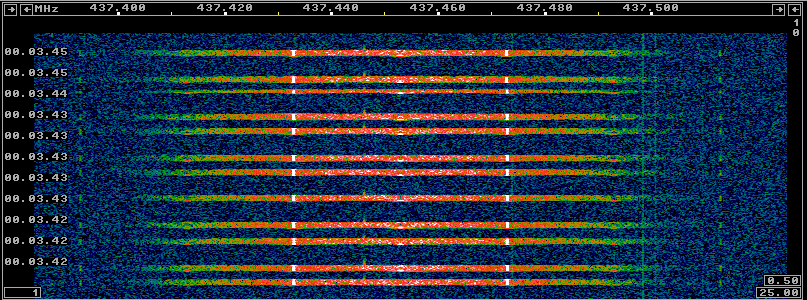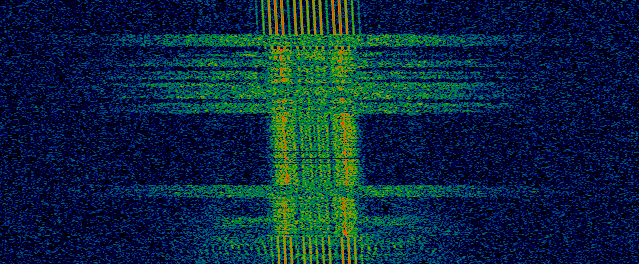Last Monday, a Chinese CZ-4B rocket launched the Chinese Earth observation satellite ZY-3 and the Argentinian satellites ÑuSat-1 and 2. These two satellites are the first of the Aleph-1 constellation of Earth observation satellites. ÑuSat-1 carries LUSEX, an Amateur payload which consists of a U/V linear transponder. Also, the two ÑuSat satellites transmit backup telemetry in the 70cm Amateur band, as one can see in the IARU frequency coordination application. In fact, the latest news is that ÑuSat-1 transmits telemetry on 436.445MHz and ÑuSat-2 uses 437.445MHz. According to the public announcements, the telemetry was supposed to be 9200 baud or 19200 baud. However, some people have noticed that, on the contrary, it is 40 kbaud. Although the modulation and coding specifications are not public, I’ve taken a look at an IQ recording of ÑuSat-2 by Mike DK3WN to see if I can decode anything. Here are my findings.
Tag: sdr
LilacSat-2 subaudio telemetry
Yesterday, the FM repeater on the Amateur satellite LilacSat-2 was active. I’ve talked about LilacSat-2 before, but so far I hadn’t made any recordings containing subaudio telemetry. While contacting several Spanish stations (EA5TT, EA1JM and EA1IW) throughout the pass, I made an IQ recording to analyse the telemetry later. Here I take a look at the telemetry format and the decoded data.
Decoding packets from GOMX-3: modulation and coding
Recently, Mike DK3WN pointed me to some decoder software for the satellite GOMX-3. This satellite is a 3U cubesat from GomSpace and transmits in the 70cm Amateur band. It has an ADS-B receiver on board, as well as an L-band SDR. As far as I know, no Amateur has decoded packets from this satellite previously, and Mike had some problems running the decoder software. I have taken a look at the software and tried my best to decode some packets from GOMX-3. So far, I have been able to do Reed-Solomon decoding and get CSP packets. However, I don’t have the precise details for the beacon format yet. Here, I describe all of my findings.
First signals from AAUSAT-4
Today I woke up early to receive the signals from AAUSAT-4 as it passed over Spain for the first time. This satellite was launched from Kourou yesterday at 21:02UTC into a Sun-synchronous orbit. The main payload for the launch was Sentinel-1B, a 5GHz Synthetic Aperture Radar satellite from the Copernicus project of the ESA. The remaining satellites that were launched by the Soyuz rocket were Microscope, from the French CNES, designed to test Einstein’s equivalence principle and the three cubesats in the Fly You Satellite! program: OUFTI-1, from the University of Liège, which carries a D-STAR amateur radio transponder, e-st@r-II, from the University of Torino, and AAUSAT-4, from the University of Aalborg, which carries an AIS receiver. Since the launch was into a polar orbit, the first pass of the Fly Your Satellite! cubesats over Spain was at 05:42UTC today.
Scanning Ku band satellites with the FUNCube Dongle
I’ve recently installed my satellite dish and modified LNBF in my garden. This equipment will be used to receive Es’hail 2, the first geostationary satellite carrying an amateur radio transponder. Here I’ll look at the hardware I’m using, how I did the alignment to the 25.5ºE geostationary orbital position where Es’hail 2 will be located, and how to have some fun scanning the direct broadcast satellites in the Ku band with a FUNCube Dongle Pro+.
Calibrating the S-meter in Linrad
In a previous post, I talked about the GALI-39 amplifier kit from Minikits. Here I will describe the procedure to calibrate the S-meter in Linrad (or another SDR) using this amplifier or any other amplifier with a known NF and an uncalibrated signal source. Leif Åsbrink has a youtube video where he speaks about the calibration of the S-meter in Linrad. However, he doesn’t use an amplifier, so I will be following a slightly different procedure.
Using Linrad as a panadapter
Recently, I installed a G4HUP PAT on my FT-817ND. This is a small board which allows one to tap the IF of a conventional radio receiver to use an SDR as a panadapter (essentially, a waterfall display which shows a chunk of spectrum about the frequency tuned on the receiver). In the previous post I described the installation of the hardware. Here I will describe how I’ve set up Linrad to suit my preferences. One interesting aspect of this set up is that I’ve ended up adding a bit of code in Linrad to make it read the dial frequency of the radio using CAT and make Linrad track the frequency as one tunes around in the radio.
Installing the G4HUP PAT on the FT-817
Today I’ve been installing the G4HUP PAT kit on my FT-817ND transceiver. This kit is essentially a buffer amplifier that allows one to tap the IF of a transceiver, in order to send it to an SDR. Then, the SDR can be used as a panadapter. This kit is intended as an entry level SMD project and it can be fitted to many popular amateur radio transceivers. In fact, this has been my first SMD project, and I have found it quite easy to solder using the right tools and technique.
Doppler correction with GNURadio
When receiving signals from a satellite, it can be important to correct for the Doppler shift in the signal. Normally, I use Gpredict to track satellites and compute the Doppler shift. Gpredict can control the frequency of a receiver using Hamlib to track the Doppler shift. When using an SDR receiver, there are several possible ways of using Gpredict’s frequency control.
Normally, the SDR software doesn’t support Hamlib control in a way that it’s useful and easy to use for this purpose. This is the case with Linrad, which is the software I use, and probably with many other popular SDR softwares. An easy solution is to let Gpredict completely control the frequency of the SDR receiver through Hamlib and prevent the SDR software from controlling the frequency. With the FUNCube Dongle Pro+, which is the receiver I normally use, this is easy to do. It can be controlled without problem with recent versions of Hamlib, and if you set the dongle in Linrad as an “Undefined” card instead of a FUNCube Dongle, then Linrad will not try to control its frequency.
The problem with this solution is that each time that the frequency gets updated, it does so in a non phase continuous manner, because the PLL of the receiver has to lock on to the new frequency, effectively losing reception for just a tiny amount of time. This supposes no problem for SSB, CW or FM reception, because your ears just don’t notice. However, if you want to receive any digital signal or SSTV, the frequency change usually messes with the decoder software, which loses sync and suffers decoding problems. An alternative solution is to leave the receiver frequency fixed and correct for Doppler shift in software.
LilacSat-2 GNUradio receiver
I have made my own LilacSat-2 telemetry GNUradio receiver using the flowgraphs included in gr-lilacsat. The new features of this receiver are the following:
- All the decoders and the frontend are run on the same flowgraph. I find this more practical than having to run all the flowgraphs separately. Also, some blocks can be reused in this way.
- It uses gr-gpredict-doppler to compensate for Doppler. As I mentioned in a previous post, I prefer this to the Doppler correcting system included in
gr-lilacsat. - It plots and outputs to a file the signal strength on 437.200MHz and 437.225MHz. This can be used for later analysis.
- It supports recording file input, or live SDR using an ALSA source (for the FUNCube Dongle Pro+, for instance). Another SDR supported by GNUradio can be easily used.
- It supports recording both the raw IQ data and the Doppler corrected IQ data. The raw IQ file can be then played back by simultaneously running Gpredict with the correct settings for the recorded pass. The Doppler corrected IQ file can be played back without running Gpredict.
This receiver can be downloaded from GitHub. The flowgraph is a bit crammed, but that’s what you get for having all the decoders in the same flowgraph. Several of the input/output blocks are disabled, so that you can choose which ones to use.




